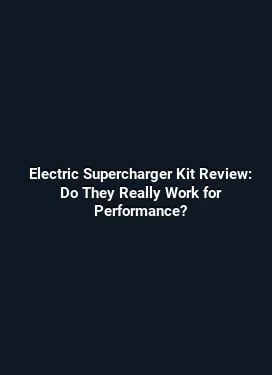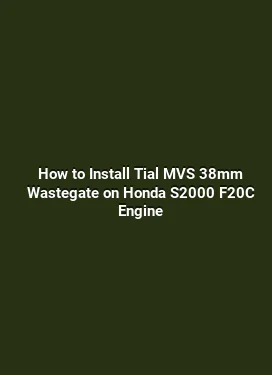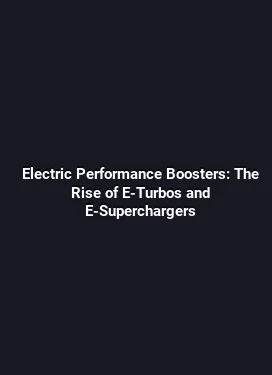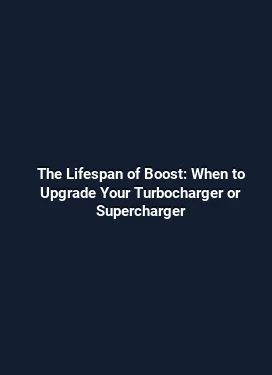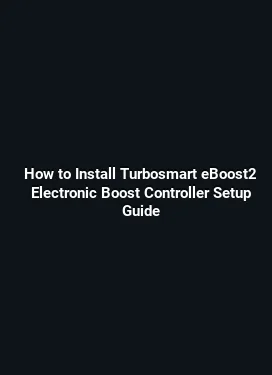The Role of Catch Cans and PCV Systems in Forced Induction Engines
Forced induction engines, including turbocharged and supercharged setups, inherently operate under higher pressures and more complex breathers than naturally aspirated powertrains. This demanding environment makes the management of crankcase vapors, blow-by gases, and intake tract cleanliness particularly critical. A well-designed PCV (Positive Crankcase Ventilation) system paired with effective catch can solutions helps maintain engine efficiency, reliability, and performance. This article delves into how these components function, their impact on forced induction performance, practical installation strategies, maintenance considerations, and common pitfalls to avoid for enthusiasts and professionals alike.
Understanding PCV Systems and Catch Cans in Forced Induction Context

The PCV system is a closed-loop ventilation strategy that routes blow-by gases from the crankcase back into the intake tract to be burned in the combustion chambers. In modern engines, PCV paths are designed to minimize emissions while preserving engine breathing dynamics. In turbocharged or supercharged applications, the increased crankcase pressures and elevated boost pressures alter the behavior of blow-by and oil vapor, making robust PCV design essential. A catch can, positioned along the PCV line, acts as a secondary filter and a reservoir to capture oil mist and condensates before they can re-enter the intake tract. The result is a cleaner intake, reduced oil vapor dilution, and more predictable air-fuel ratios at high boost.
Key components in this ecosystem include the drive mechanism for PCV valve operation, vacuum source strength, oil vapor separation efficiency, and the routing of hoses to minimize pressure drops and heat transfer. For forced induction engines, the PCV system must cope with higher intake vacuum or pressure differentials depending on throttle position and boost state. The added complexity is worthwhile when considering the potential benefits: lower intake tract deposits, reduced carbon buildup, and more stable turbocharger performance due to consistent scavenging of crankcase vapors.
How Blow-By Affects Forced Induction Performance

Blow-by gases arise when the combustion pressures push past the piston rings, allowing combustion products, fuel vapors, and oil aerosols to migrate into the crankcase. In boosted engines, the pressure differential across the piston rings is influenced by boost, engine speed, and cylinder wear. This means blow-by can be more pronounced under load, particularly during transient boost ramp-ups. If unchecked, crankcase vapors can backflow through the PCV valve into the intake, leading to oil ingestion, increased intake manifold deposits, and potential detonation risks due to oil film formation on the intake ports. A well-specified catch can helps mitigate these risks by separating oil from the vapor stream before it re-enters the engine’s air mass.
Another consideration is temperature. Oil aerosolization and vapor pressure rise with heat, especially in hot-turbo or high-boost scenarios. Capturing those aerosols before they reach the intake not only preserves intake air density but also reduces carbon buildup on intake valves and runners. This environmental control translates into more consistent fuel metering and smoother throttle response across a broad RPM range.
Practical Configurations for Turbocharged and Supercharged Setups
When designing a PCV and catch can strategy for a forced induction build, the goal is to balance effective separation with minimal inductive losses. The typical approach uses a primary PCV valve to manage low-to-moderate crankcase vacuum, complemented by a catch can in a position that intercepts the most oil-laden vapor path before it reaches the intake tract. For high-boost applications, additional considerations include bypass routing during cold starts, heat management, and the potential need for a second stage catch can to handle elevated oil carryover. Below are common configurations and the reasoning behind them.
Baseline PCV Route with a Single Catch Can
This setup uses a PCV valve connected to a short runner that taps from the crankcase and routes clean air back into the intake after the catch can. The catch can is placed in a high-vent line (often between the PCV valve and the intake manifold) so that oil-laden vapors first pass through baffles or a filtration medium. The benefit is straightforward: reduced oil carryover and lower aerosol loading on the intake track. For many street applications, this configuration provides a reliable balance between simplicity and performance, especially when paired with a quality oil mist separator inside the catch can body.
Dual-Path Configurations for High-Performance Workloads
In high-boost or track-oriented builds, engineers may implement a dual-path catch can system. A dedicated bypass line frees the PCV path during heavy loads, directing blow-by away from the intake at peak manifold pressures. When boost subsides, the system reverts to a standard PCV route to prevent crankcase pressure buildup. This approach helps maintain stable valve timing and reduces the risk of oil pooling in the intake tract during rapid throttle transitions. A well-executed dual-path arrangement requires careful tuning of valve spring rates and vacuum sourcing to avoid sensitive hunting or stalling during rapid boost changes.
Installation Best Practices and Maintenance Considerations
Quality installation is critical to realize the potential of PCV and catch can upgrades. The objective is to ensure consistent vacuum supply, minimize turbulence, and prevent oil leaks in hot environments. Practical steps include selecting heat-resistant hoses with appropriate clamps, routing lines away from hot exhaust sections, and using a catch can with proven separation efficiency. A good catch can features internal baffling, a reliable check valve arrangement, and a cleanable oil collection chamber to facilitate periodic maintenance. For forced induction engines, attention to vacuum depth, line sizing, and anti-siphon measures helps keep the system stable under varying boost and engine speeds.
Positioning, Sizing, and Flow Considerations
Line sizing should reflect the maximum expected crankcase pressure and the desired response time of the PCV system. Undersized lines can create bottlenecks, causing PCV valve chatter or delayed crankcase venting, especially during gear changes or hard acceleration. Oversized lines may reduce the scavenging efficiency, which is counterproductive in a boosted application. The position of the catch can relative to the PCV valve influences the amount of vapor that bypasses the separator. Ideally, the catch can sits downstream of the crankcase and upstream of the intake to maximize separation before re-ingestion of oil into the combustion chamber. Regular inspection intervals should be established to clean or replace the filtration media and to confirm there are no oil leaks or brittle hose sections in high-heat zones.
Diagnostics, Troubleshooting, and Performance Indicators
Diagnosing PCV and catch can performance involves a combination of visual inspection, performance metrics, and sometimes diagnostic scans. Indicators of suboptimal PCV performance include increased oil on the throttle body, excessive oil accumulation in the intake manifold, rough idle after cold starts, and reduced boost response due to intake tract contamination. A sudden dip in volumetric efficiency or unexpected fuel trims can also hint at PCV-related oil ingestion or vapor leakage. Regularly checking for oil film residues on the intake valves and runners, particularly after track sessions or high-load tests, helps identify whether the catch can system is operating as intended. A healthy system should show minimal oil carryover and stable air-fuel behavior across RPM bands and temperature ranges.
Troubleshooting Scenarios and Remedies
Common issues include cracked hoses, deteriorating seals, or venting blockages caused by oil buildup on the baffles. In turbocharged builds, elevated boost can exaggerate these problems, so it is prudent to inspect the catch can’s internal media for clogs and ensure the reservoir isn’t siphoning oil back into the intake. If boost leaks or vacuum leaks are detected, reseating clamps, replacing damaged components, and confirming hose routing is essential. For persistent oil in the intake tract, evaluating the oil type and viscosity in relation to the engine’s thermal load can uncover mismatches that contribute to excessive vaporization. Upgrading to a higher-efficiency oil mist separator and using high-temperature hoses can provide additional resilience in demanding applications.
Component Selection, Upgrades, and Installation Tips
Choosing the right catch can and PCV components depends on the engine’s displacement, boost targets, oil consumption characteristics, and the intended usage pattern. The selection process should account for oil separation efficiency, pressure handling, heat resistance, and serviceability. Modern catch cans employ sophisticated baffle systems, coalescing media, and integrated breathers designed to minimize oil carryover while allowing the vapor to vent back into the intake stream. When upgrading, prioritize compatibility with the vehicle’s vacuum and boost sources, and ensure that the system remains serviceable after installation so that maintenance intervals align with the engine’s service schedule.
Practical Guidelines for Upgrading
Begin with a clear map of the crankcase ventilation flow, verifying mounting points, hose lengths, and routing to avoid kinks and heat sources. Choose a catch can with a reputable oil separation performance, easy drain access, and reinforced mounting hardware. Ensure the PCV valve is suited for the engine’s expected vacuum range and that the system remains sealed during high-boost operation to prevent unmetered air from entering the intake. When wiring or plumbing is involved, use heat-resistant fasteners and ensure that all connections are clamped securely to withstand vibrations and dynamic loads during aggressive driving. Documentation and color-coding of lines can simplify future diagnostics and maintenance tasks.
Understanding the interaction between catch cans, PCV systems, and forced induction is not merely about preventing oil from entering the intake. It’s about preserving intake tract cleanliness, maintaining predictable air flow, and supporting consistent ignition timing and fuel delivery across a broad spectrum of operating conditions. This holistic view helps engineers and enthusiasts design robust, reliable boosted engines capable of delivering sustained performance without compromising longevity. The tangled realities of boost, blow-by, and oil management demand practical knowledge, careful installation, and proactive maintenance to unlock the true potential of modern forced induction platforms.

